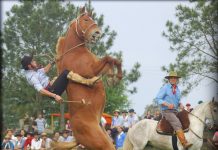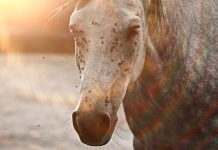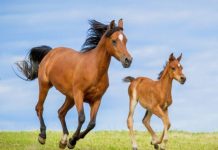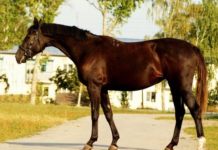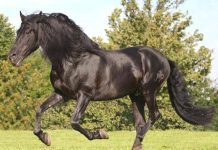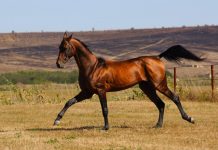They are still half-wild, the horses of the Camargue. The Camargue white horse, also known as “crin blanc” (the white mane) in French. And they are still the pride of their riders.
Camargue horses live, as the name suggests, in the swamps of the Camargue, the beautiful Rhône Delta, and the wide gravel plains of the Crau in southern France.
Are you interested in a Camargue horse? In this article, you will find everything you need to know about the gray horses of southern France, the Camargue horses.
Breed description

The Camargue horses are sturdy small horses that live in the region of the same name – the Rhône Delta – and in the Crau, a gravel plain in southern France.
Despite their height of 130 cm to 150 cm, Camargue horses are small horses and not ponies. The main breeding area of the Camargue horses is in southern France.
There are now some responsible breeders of this horse breed in Germany. Camargue horses are exclusively gray.
Size: 130-150 cm
Weight: 300 – 400 kg
Origin: South France
Lifespan: 20-30 years
Color: Mold, fly, and trout mold
Dressage, leisure, western, draft horse
Origin and breed history
The origin of the Camargue horses lies in the Rhône Delta. How long these robust horses have been around cannot be precisely determined.
Some experts believe that this breed of horse is a descendant of the horses that the Saracens left behind in the Camargue in the 8th century.
Other experts believe that the Camargue horses are descendants of the Solutré horse, a prehistoric small horse whose existence is estimated to be 5000 years.
Genetic traces of other oriental horse breeds can still be found in today’s Camargue white horses: those of the Arabs and Berbers.
Subsequent attempts to cross other horse breeds into the breed of the Camargue white horse in order to breed larger horses were unsuccessful and were quickly discontinued.
They were first mentioned by the Roman general Gaius Iulius Caesar.
The Roman general was so enthusiastic about the speed, agility, and courage of these small, white horses that he founded two-game studs in the area of Arle, in the then province of Aquitaine and in “Langedock-Roussilion”, around Camargue himself Breeding horses for the Romans.
From then on, the Camargue horses were used by the Romans for their famous chariot races and for military use. The Camargue horses are bred by Manadiers – French horse and bull breeders – in wild stud farms.
Wild studs or wilderness studs are studs that are not operated in a commercial manner but on natural areas. Here the horses can move freely and naturally under the supervision of a shepherd.
Camargue horses are kept in this way to this day and shape the landscape of the Camargue and the Crau alongside the bulls. The beautiful gray horses are still bred mainly for herding bulls.
The black bulls that are typical of the Camargue and are bred for the French, bloodless bullfighting are small but very spirited and dangerous.
To work with the herds of bulls, the Gardians, the bull keepers, needed an agile, fast and responsive horse. A horse that “thinks” at work and, like the American Quarter Horse, has a natural “cow sense”.
The cow sense describes the horse’s ability to adapt to the movements and reactions of a cattle or cattle with its actions.
This cow sense is mostly natural, but it can also be trained. The Camargue horses are used in a variety of ways. Usually, it has to do with herding the fighting bulls. They drive the bulls into the arena. The arrival of the bulls is called abrivado, the departure of the bulls to the pastures is called bandido.
The Camargue horses are also used to sort out the young bulls, the so-called ferrade, and in processions on public holidays. These customs have made the Camargue horses an integral part of the southern French culture.
In the course of time, various equestrian games were developed in which the Gardians can show the speed, agility, and skill of their Camargue horses.
The main aim of all games is to attract the attention of a young lady in a typical Arles national dress – the “Arlesiennes”.
Around 70 semi-wild herds still live in the Camargue and the Crau. The horses are caught, vaccinated, and burned only once a year.
Although there is no longer any official castration obligation for Camargue stallions, the stallions unsuitable for breeding are still neutered at around three years of age in order to keep the breeding healthy and the young stallions fit for work are removed from the herd.
This keeps the number of horses small. It was not until the late 1960s that the Camargue horses were recognized as a separate breed. In 1975 the first breeding of the wonderful gray started here in Germany, but there are requirements.
Only horses that were born in a wilderness stud in the Camargue are allowed to bear the breed designation “Camargue horses”. Horses that saw the light of day here in Germany, for example, have the designation “Hors Berceau” in their breeding papers, in English: “Born outside the cradle”.
The appearance of the Camargue horses
The rough, barren and sometimes impassable landscape of the Camargue and the Crau have shaped the Camargue horses. All are of strong build and strong ankles with strong joints.
Characteristic is the large and hard hooves, which usually do not need to be shod and which do not sink even in swampy soil. The head, often with Ram’s nose, is large and has a broad forehead and a straight profile.
The ears are small and are carefully moved. The wonderful big eyes are very expressive. The physique is compact, with a short, strong neck that is set deep. The gaiters large, the shoulders steep, short, and well-muscled.
The back of most Camargue horses is straight, short to medium length, and ends in a strong croup. The well-proportioned, dry limbs have good muscles, strong joints, and strong ankles.
The hooves have adapted to the habitat of the Camargue horses and are hard and round. They do not sink, even in swampy soils, and usually do not need to be fogged up.
Camargue horses are known only as white horses with no dark markings. But fly or trout mold are also possible. Here the habitat has influenced the color of the Camargue horses. The white of the fur reflects the sun’s rays and has an insect repellent effect.
The foals of the Camargue horses are born dark brown or black. Many of them show pronounced white circles under the eyes, which indicate the later white fur. Camargue horses take a long time to achieve their final color.
It can take up to four years for the fur to shine in its typical white. The characteristic of the Camargue horses is the strong growth of beard, which is even evident in the foals, and the hangings on the belly.
Camargue horses are late-developing, mostly they are not fully grown until they are seven or eight years old.
Temperament and essence

Life as a wild horse in the swamps of southern France has also shaped the character of the Camargue horses in a very special way. It is the calm character, the quick perception of the horses, their serenity, the cleverness, and the perseverance and the joie de vivre that makes the Camargue horses so unique.
The courage of this little gray horse is second to none. They have to be brave and very sure-footed because when looking after the herd of bulls it can happen that the nimble, small, and agile horses gallop right in front of the herd of bulls in order to direct them in the desired direction.
Horses are considered escape animals. Not so with the Camargue horses. The long years that they have been living in the swamps of France have taught them one thing: not to rush off headlessly.
If the Camargue horses are frightened, they first standstill to see if and where they are in danger. Because experience has shown them that a panic escape in the wetlands could be fatal.
So it is not surprising that dead bulls and other animal species are found again and again, but only very rarely one of these highly intelligent and cautious small horses. The Gardians are still closely related to their horses.
They pride themselves on their intrepid, persistent, and friendly Camargue white horses. According to tradition, it even happened that a Gardian put up a tombstone in memory of a loyal and beloved Camargue horse after his death.
Husbandry and nutrition
Attitude
It is advisable to keep Camargue horses on pasture and within a herd all year round, if possible.
Fallow areas with marshland, brook, or spring areas are ideal. A pure box position is possible, but the Camargue horses’ natural urge to move suffers.
Even with overnight accommodation in a box, Camargue horses suffer more than the owner assumes. The sturdy small horses are used to spending day and night outdoors, summer and winter. The origin of the animals should also be included in the diet.
Camargue horses are good to feed converters, i.e. easy to feed, so the feeding should be adapted as closely as possible to the original conditions.
Feeding too protein-rich food should be avoided. The pretty white horses of the Camargue have a special characteristic. They can close their nostrils while eating underwater.
Nutrition
As with dogs, cats, or small animals, nutrition also plays an important role in horses in order to keep them as healthy as possible.
When it comes to keeping and feeding, Camargue horses are absolutely uncomplicated, as they have become frugal and tough through living in the harsh landscape of southern France.
They are satisfied with what they are offered. Camargue horses can cope with hot as well as humid and cold weather conditions.
Of course, you should use high-quality food for feeding.
Education and care
Upbringing
Camargue horses are easy to train due to their calm character and their high intelligence and quick perception.
However, the owner should be careful here, because as quickly as the Camargue horses learn new things, they also internalize mistakes that the owner has made during their upbringing.
The upbringing and the attitude should be worked with loving consistency. If you tackle a Camargue horse too hard, the otherwise good-natured, obedient, and patient gray horse can quickly react with extreme stubbornness.
Maintenance
Camargue horses are cared for like any other horse breed.
Regular brushing of the coat, mane, and tail, like hoof care, is part of good care.
Health and Typical Diseases
Camargue horses are robust and healthy animals. They are considered to be resistant to most diseases. So that it stays that way, the feed and posture should be adjusted.
Life alone in a box, no matter how beautiful, warm and cozy, is not for the frugal horse.
The life expectancy of the Camargue horses
Since Camargue horses are extremely resilient and rarely get sick, they can live up to 30 years.
Buy Camargue horses
Real Camargue horses can be obtained directly from a Manadier from the Camargue, i.e. a Camargue horse breeder.
If the way to the south of France is too far for you, there are also some very good and responsible breeders of Camargue horses in Germany.
The best way to find out about a good breeder of this great horse breed is through the Association of Camargue Horses Germany.
Decision support
If you are looking for a recreational horse for long trail rides through different terrain, a Camargue is a right choice for you.
Camargue horses are very sure-footed, even on difficult ground and terrain, and they have extreme stamina. Because of their height, Camargue horses are also very suitable for smaller riders. They are sturdy, confident, calm, obedient, and brave.
But Camargue horses are also ideal for pulling carriages because of their high resilience. Camargue horses are intelligent and quick to grasp. You could say they like to learn.
Therefore, they can also be used very well in dressage riding.
FAQ on Camargue horses

How long do Camargue horses live?
Camargue horses have a life expectancy of 20 to 30 years.
How big do Camargue horses get?
Camargue horses are 130 to 150 cm tall.








